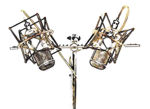| Columns Retired Columns & Blogs |
A Mosaic of Music: Stereophile's Clarinet Quintet CD Page 2
By adjusting the balance and the time alignment between the two pairs of microphones in post-production, I would be able, I hoped, to eat my cake and have it, too: capture the natural tonality of the instruments and the bloom of Blue Heaven's church ambience, and present a true picture of the five musicians within that space. In the end, I did tend to sacrifice a little of the imaging specificity in favor of the sound's bloom, feeling that this gave a little more envelopment. But that's why recording is an art, not a science.
 One of the things underlying Stereophile's recording projects is that they feature maximum signal purity. Even with multimiked, multichannel CDs like Rendezvous and Bravo!, the latter recorded live at the 1998 Santa Fe Chamber Music Festival (STPH014-2), no mixing console is used. Instead, the outputs of the mikes are amplified with low-noise preamplifiers and fed straight to the analog/digital converters. All subsequent editing, mixing, and signal processing is done in the digital domain, with great care taken to preserve audio quality at every stage.
One of the things underlying Stereophile's recording projects is that they feature maximum signal purity. Even with multimiked, multichannel CDs like Rendezvous and Bravo!, the latter recorded live at the 1998 Santa Fe Chamber Music Festival (STPH014-2), no mixing console is used. Instead, the outputs of the mikes are amplified with low-noise preamplifiers and fed straight to the analog/digital converters. All subsequent editing, mixing, and signal processing is done in the digital domain, with great care taken to preserve audio quality at every stage.
In the case of Mosaic, the four microphone signals were taken to a pair of two-channel solid-state preamps from Millennia Media and converted to digital at 24-bit resolution and an 88.2kHz sample rate with a pair of two-channel A/D converters from dCS. (These were linked so that the same word clock was used for all four channels—essential for post-production and mixing.) But four-channel, high-resolution digital recorders are rare and expensive beasts—so, as I did for Robert Silverman's Beethoven piano sonata cycle (see the article in the January 2001 issue of Stereophile), I used a four-channel, open-reel Nagra-D recorder for the cardioid mikes and an eight-channel Tascam MDM recorder for the omnis. In the case of the 24-bit Nagra, each channel of the 24/88.2 information was spread over two on-tape channels; for the Tascam, which has a word depth of only 16 bits, a PrismSound "bit splitter" was used to spread each hi-rez channel over four MDM channels.

The two recorders couldn't be played back in synchronization at the sessions, but that didn't matter. Sessions are for making music and gathering data; back home, once I'd uploaded the session data onto my digital audio workstation's hard drives, synchronized playback would be trivially easy as I assembled the recorded performances. And as I used a sample rate of 88.2kHz, the 24-bit masters could be used for possible DVD-A release or even transformed to a DSD datastream for release on SACD. (I used 88.2kHz rather than the more familiar 96kHz because the downconversion to the CD's 44.1kHz is virtually guaranteed to be transparent, as each 44.1kHz sample point is represented in the original 88.2kHz data.)
Once we had found optimal places for the mikes, the musicians arranged themselves on what had been the altar, balancing the sound in the room against their need to be able to hear and see each other. Antony decided to sit at the right of the stage, with the viola to his left, the cello appropriately in the center to provide the music's pitch foundation, and the two violins to the left. I followed the scores in the control room, watching the musicians via a video feed set up by Blue Heaven's resident engineer, John Brandt. John also gave me a monitor feed via the control room's Tannoys, but I used my usual Stax electrostatic headphones as well.
 "Mozart, Movement One, Take One," I slated the first take, and we were off, rolling tape. Blue Heaven's church acoustic lived up to its pedigree, enveloping the group and supporting the musicians. Traffic noise occasionally intruded—at predictable times, thank goodness, when the school a few blocks away emptied out, and in the evening rush hour—as did a police helicopter, when the group was going for broke in a final performance of the Brahms. But 105 takes of the Mozart and 102 takes of the Brahms later, we had gotten everything down on tape in two days of intense music-making.
"Mozart, Movement One, Take One," I slated the first take, and we were off, rolling tape. Blue Heaven's church acoustic lived up to its pedigree, enveloping the group and supporting the musicians. Traffic noise occasionally intruded—at predictable times, thank goodness, when the school a few blocks away emptied out, and in the evening rush hour—as did a police helicopter, when the group was going for broke in a final performance of the Brahms. But 105 takes of the Mozart and 102 takes of the Brahms later, we had gotten everything down on tape in two days of intense music-making.
Ahead lay many hours of editing, mixing, and mastering, and many, many discussions with Antony and Adrian Levine about which were the takes in which everything had clicked. But our subsequent drive to Chicago, where the quintet was to perform live at the HI-FI '99 Show, sponsored by then Musical Fidelity distributor Audio Advisor and broadcast live on Chicago's premier WFMT classical radio station, was colored by the feeling of satisfaction that comes when all involved feel they have been the vehicles for something larger than their individual efforts. I hope you enjoy the result.—John Atkinson
- Log in or register to post comments




































